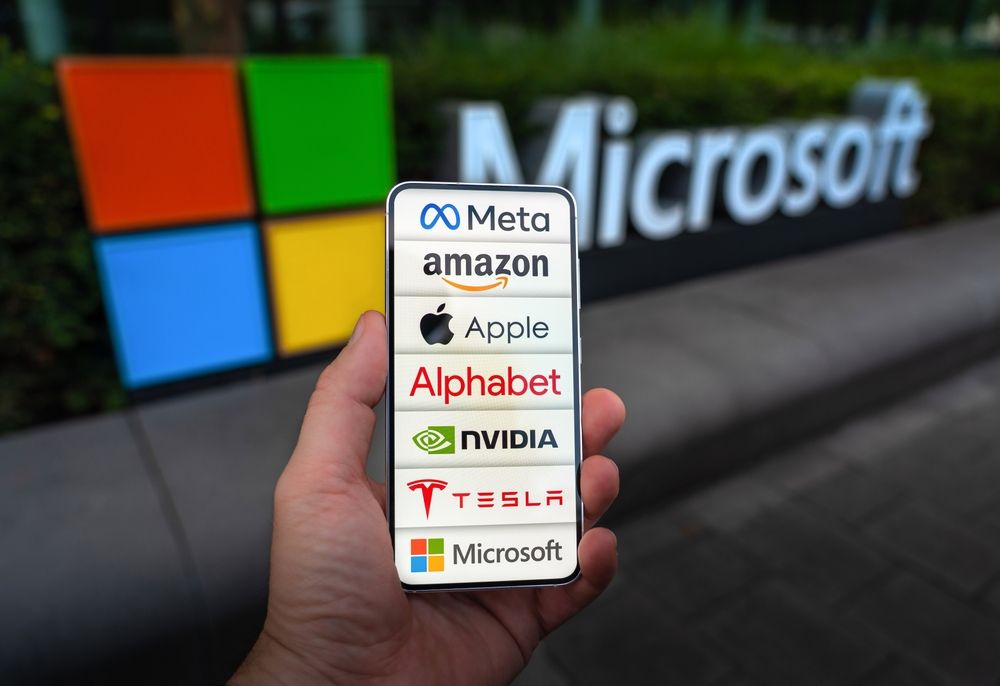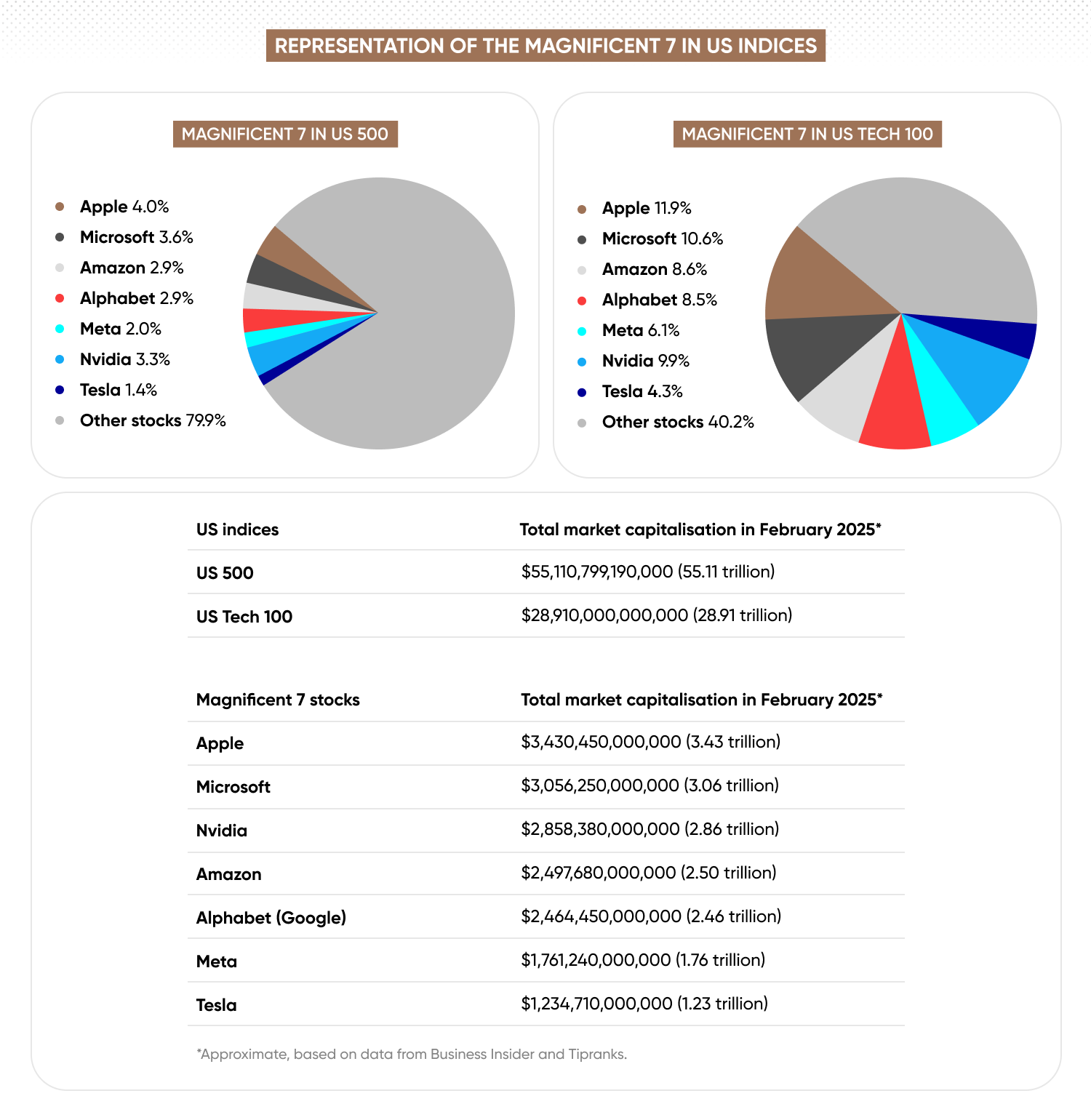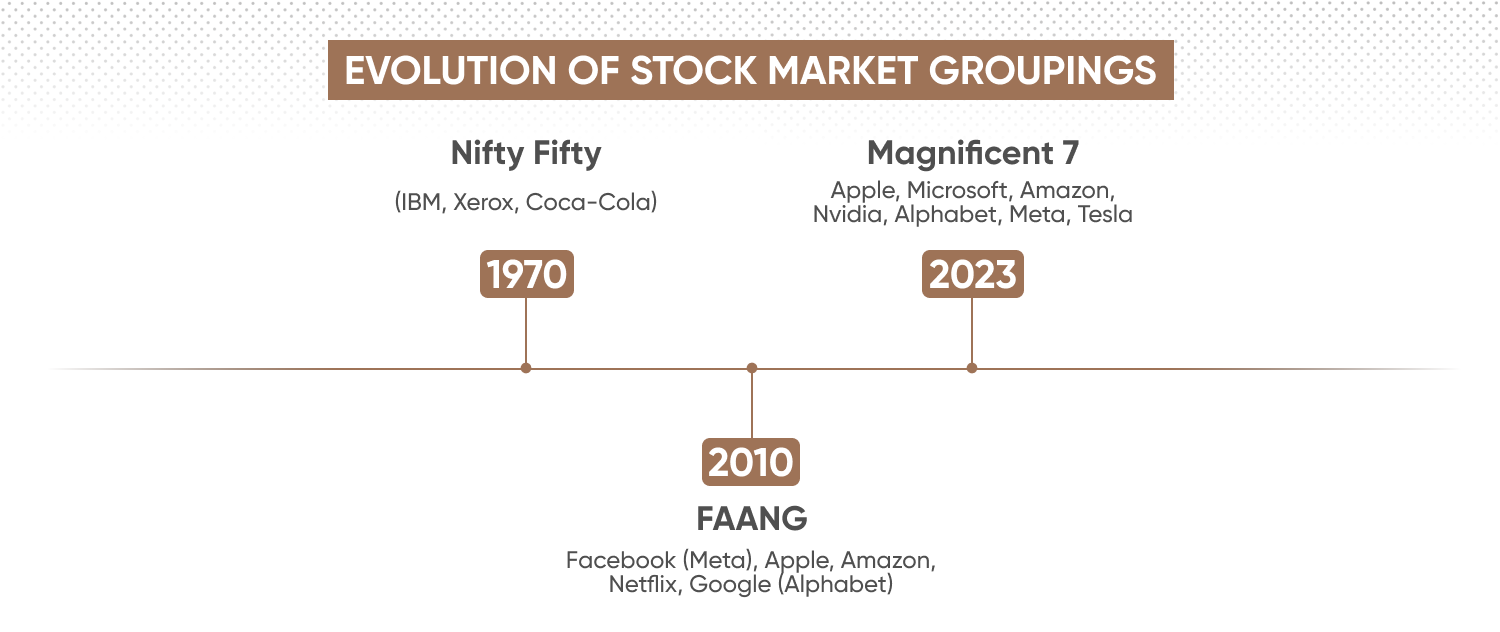What are the Magnificent 7 stocks?

What is the Magnificent 7?
The Magnificent 7 is a group of seven US stocks which are significant due to their size, growth, and influence in tech-related sectors. Popularised in 2023 by Bank of America analyst Michael Hartnett, the Magnificent 7 grouping is an evolution of earlier classifications such as FAANG (Facebook (Meta), Apple, Amazon, Netflix, and Google, now known as Alphabet) and reflects the increasing dominance of high-growth, innovation-focused businesses in the stock market.
Unlike a structured index, the Magnificent 7 is an unofficial designation determined by market influence rather than set inclusion criteria. Their performance is closely tied to the US Tech 100 and US 500, where they hold a substantial weight. As a result, price movements in these stocks can reflect broader market trends.
As of February 2025, the Magnificent 7 stocks account for over 30% of the US 500’s and almost 60% of the US Tech 100’s total market capitalisation.

Which stocks are in the Magnificent 7?
The Magnificent 7 comprises Apple, Microsoft, Amazon, Alphabet, Meta, Nvidia, and Tesla. These are stocks recognised for their strong market positions, revenue growth, and influence on global stock indices.
|
# |
Company |
Stock |
Industry |
Key focus |
|
1 |
Apple |
Consumer technology |
iPhone & Mac sales, in-house chip innovation, AI-driven software enhancements. |
|
|
2 |
Microsoft |
MSFT |
Technology & cloud computing |
AI-powered enterprise tools, AI research and development, Azure cloud services. |
|
3 |
Nvidia |
NVDA |
Semiconductors & AI |
AI GPUs for data centres, H200 and Blackwell chip series, AI hardware leadership. |
|
4 |
Amazon |
E-commerce & cloud |
AWS cloud infrastructure, AI-powered logistics, Prime subscriptions. |
|
|
5 |
Alphabet |
GOOGL |
Search & cloud computing |
Google Search, AI models (Gemini), YouTube ad revenue. |
|
6 |
Meta |
META |
Social Media & AI |
AI-driven ad targeting, Llama AI models, Instagram & WhatsApp growth |
|
7 |
Tesla |
TSLA |
Electric vehicles & AI |
Full Self-Driving (FSD) software, EV production scaling, AI robotics |
1. Apple (AAPL)
Apple remains a dominant force in consumer technology, generating the majority of its revenue from iPhone sales. Apple is expanding its AI capabilities through in-house silicon development (M-series and A-series chips) and AI-powered features in iOS and macOS. Its services segment – including iCloud, Apple Music, and App Store – provides recurring revenue, supporting long-term growth.
-
Learn more about Apple shares in our Apple trading guide.
2. Microsoft (MSFT)
Microsoft has strengthened its position in AI and cloud computing through Azure, its second-largest cloud platform after AWS. The company’s partnership with OpenAI has allowed it to integrate AI models like ChatGPT into its products, including Microsoft 365 and Copilot. Microsoft enterprise software, including Windows and Teams, consistently drives revenue in corporate markets.
-
Find out more about Microsoft in our Microsoft trading guide.
3. Nvidia (NVDA)
Nvidia is a leader in the AI semiconductor industry, with its high-performance GPUs powering AI training and data centre applications. The H100 and Blackwell GPU series are widely used in AI models, cloud computing, and autonomous vehicle development. Nvidia’s gaming and professional visualisation segments also benefit from AI advancements in rendering and graphics.
-
Discover more about Nvidia in our Nvidia trading guide.
4. Amazon (AMZN)
Amazon’s cloud division, AWS, generates the majority of its profits, providing AI and cloud computing solutions to businesses worldwide. Amazon also integrates AI across its e-commerce operations, using machine learning for personalised recommendations, automated fulfilment centres, and drone delivery systems. Subscription services, including Prime and Amazon Music, contribute to its diversified revenue streams.
-
Read more about Amazon in our Amazon trading guide.
5. Alphabet (GOOGL)
Alphabet dominates digital advertising and search through Google, which holds over 90% of the global search market. Alphabet is investing heavily in AI, with Gemini (formerly Bard) enhancing search capabilities and Google Cloud expanding AI-driven services. YouTube remains a major revenue driver, benefiting from AI-powered recommendations and advertising.
-
Learn more about Alphabet (formerly Google) in our Alphabet trading guide.
6. Meta (META)
Meta develops AI to improve its advertising model across its Facebook, Instagram, and WhatsApp services. Its Llama AI models enhance generative AI applications, while AI-powered recommendations increase user engagement. Despite challenges in the metaverse space, Meta’s core business remains strong, with increasing ad revenue and cost-cutting measures improving profitability.
-
Find out more about Meta in our Meta trading guide.
7. Tesla (TSLA)
Tesla is a leader in electric vehicles and autonomous driving technology, with its Full Self-Driving (FSD) software being a key AI-driven initiative. Tesla is developing AI-powered robotics, including the Optimus humanoid robot – and energy storage solutions with its Megapack battery systems – as part of its long-term innovation strategy.
-
Read more about Tesla in our Tesla trading guide.
How are the Magnificent 7 stocks selected?
The Magnificent 7 is an informal classification rather than a stock market index, meaning there are no fixed criteria for inclusion. Instead, these stocks are recognised based on their market lead, financial performance, and substantial influence on major indices.
Several factors contribute to a company’s inclusion in the Magnificent 7:
-
Market capitalisation: the Magnificent 7 stocks are among the largest publicly traded companies by market value. Their combined capitalisation accounts for a significant portion of major indices like the US 500 and US Tech 100.
-
Historical performance: companies within the Magnificent 7 consistently generate high revenues and strong profit margins. While profitability has varied across these firms, their long-term revenue expansion has remained a key characteristic.
-
Influence on stock indices: these stocks hold substantial weight in major indices, meaning their price movements may impact overall market performance and sector trends.
-
Innovation and industry leadership: the Magnificent 7 is composed of leading stocks in high-growth sectors such as artificial intelligence (AI), cloud computing, e-commerce, semiconductors, electric vehicles, digital advertising, and consumer electronics.
Changes in market trends, financial performance, or competitive landscapes may result in adjustments to the Magnificent 7’s future composition.
Has the Magnificent 7 changed over the years?

The Magnificent 7 gained prominence in 2023 as a recognition of the most influential technology-driven stocks, reflecting the dominance of AI, cloud computing, and high-growth firms in financial markets. Magnificent 7 follows a long history of significant stock groupings, such as the Nifty Fifty and FAANG.
In the 1970s, the Nifty Fifty represented a collection of large-cap, high-growth US stocks, primarily in industrials, consumer goods, healthcare, and emerging technology sectors. Companies like IBM, Xerox, and Coca-Cola were considered ‘one-decision’ stocks – businesses expected to grow indefinitely regardless of economic conditions. However, many failed to sustain their momentum, and the 1973-74 market crash exposed their overvaluations.
Fast-forward to the 2010s, and FAANG – an acronym for Facebook (now Meta), Apple, Amazon, Netflix, and Google (now Alphabet) – was popularised by market commentators, including Jim Cramer. These firms led the digital revolution, benefiting from the rise of social media, mobile technology, and e-commerce – but by the early 2020s, the group became less representative of the top-performing technology firms.
By 2023, the transition to the Magnificent 7 – Apple, Microsoft, Amazon, Alphabet, Meta, Nvidia, and Tesla – reflected broader market trends. Rather than replacing FAANG outright, the Magnificent 7 expanded the focus to include AI-driven hardware, semiconductors, and enterprise software, acknowledging shifts in market leadership and sentiment.
Trading the Magnificent 7: Potential risks and opportunities
The Magnificent 7 stocks present potential trading opportunities, driven by their market dominance and innovation. However, they also come with potential risks due to valuation concerns, regulatory scrutiny, and sector-specific challenges.
AI-driven growth and competition
The Magnificent 7 includes some of the leading US AI stocks, with Nvidia leading in AI chip production, Microsoft integrating OpenAI technology, and Alphabet advancing its Gemini AI model. AI adoption from key industries is a key driver of revenue growth. However, competition is intensifying as AMD has introduced its MI300 series AI GPUs to rival Nvidia’s products – while Meta is developing proprietary AI models (such as Llama), while Apple is exploring AI integration to reduce reliance on third-party providers. If competitors successfully capture market share, margins for AI leaders could be pressured.
Tech sector representation and diversification
The Magnificent 7 collectively accounts for nearly 60% of the US Tech 100 and over 30% of the US 500 by market capitalisation. This weighting means they can significantly influence broader market movements. In a bullish tech environment, these stocks may outperform, potentially benefiting from strong trading sentiment and high institutional demand. But their heavy reliance on technology means they might be influenced by potential sector downturns, such as if AI investment slows, cloud spending weakens, or semiconductor demand declines.
Regulatory scrutiny and adaptation
The US Department of Justice opened an antitrust lawsuit against Apple in March 2024, asserting that the company’s dominance in the US smartphone market amounts to an illegal monopoly. However, companies are adapting. Microsoft pre-emptively unbundled Teams from Office in Europe to avoid penalties, and Apple is restructuring App Store fees to comply with EU regulations. Successful management of regulatory risks or successful resolution of ongoing legal proceedings may contribute to short-term price stability.
Valuations & earnings
The Magnificent 7 stocks trade at premium valuations, with Nvidia’s price-to-earnings (P/E) ratio has exceeded 60x at times, and Tesla’s growth prospects relying on long-term AI, EV adoption, and energy storage expansion. High multiples may be sustained if earnings continue to grow, especially in AI, cloud computing, and semiconductor markets. On the flip side, an earnings slowdown might push the price lower. If cloud spending decelerates, then revenue growth at Microsoft, Amazon, and Alphabet could drop. Likewise, if Tesla faces demand concerns or margin compression from price cuts, its valuation may come under pressure.
Macroeconomics & interest rates
Positive economic outlook, rising corporate AI investment, government contracts, and government incentives for chip production (such as the US CHIPS Act) can influence Magnificent 7 stocks to rise.
However, interest rate hikes remain a key risk. If central banks maintain higher rates for longer, demand for growth stocks could reduce due to higher discount rates on future earnings.
-
Discover more about the stock market in our comprehensive shares trading guide.
How to trade the Magnificent 7 via CFDs
The ‘Magnificent 7’ stocks – Apple, Microsoft, Alphabet, Amazon, Nvidia, Meta, and Tesla – can be traded through various instruments, including contracts for difference (CFDs). CFDs allow traders to speculate on price movements without owning the underlying shares, enabling both long and short positions.
-
Choose a trading platform: select a regulated CFD broker that offers access to the Magnificent 7 stocks with competitive spreads and trading tools.
-
Decide on a trading strategy: determine whether to go long (buy) if you expect the stock price to rise, or short (sell) if you anticipate a decline. Pick trading strategies informed by fundamental analysis, technical indicators, and market sentiment.
-
Use risk management tools: consider risk management tools to help mitigate potential losses. Stop-loss orders can limit potential losses*, while take-profit aims to protect potential gains. Check out our comprehensive risk management guide.
-
Analyse market trends: monitor economic data, earnings reports, and sector trends that could impact price movements.
-
Execute your trade: open a position based on your analysis and chosen strategy, adjusting your approach as market conditions change.
*Stop-losses are not guaranteed. Guaranteed stop-losses may incur additional costs.
Discover more about CFDs in our comprehensive CFD trading guide.
FAQ
What is the Magnificent 7?
The Magnificent 7 is a group of seven US-listed stocks – Apple (AAPL), Microsoft (MSFT), Amazon (AMZN), Alphabet (GOOGL), Meta (META), Nvidia (NVDA), and Tesla (TSLA) – that are recognised for their market influence, earnings potential, and dominance in high-growth sectors such as AI, cloud computing, and semiconductors.
Popularised in 2023, the ‘Magnificent 7’ grouping reflects the increasing weight of these stocks in major indices like the US 500 and US Tech 100.
How do I trade or invest in the Magnificent 7?
Traders and investors could gain exposure to the Magnificent 7 in several ways:
-
Stock trading: Buying shares directly.
-
CFDs (Contracts for Difference): Trading price movements without owning the underlying stock, allowing both long (buy) and short (sell) positions.
-
ETFs (Exchange-Traded Funds): Investing in funds that include Magnificent 7 stocks as part of a diversified portfolio.
-
Options trading: Using call or put options to speculate on price changes or hedge positions.
Before trading, consider factors such as market trends, earnings reports, and risk management tools like stop-loss orders.
Is there an ETF for the Magnificent 7 stocks?
There is no dedicated ETF that exclusively tracks the Magnificent 7 stocks. However, they are heavily weighted in various broad-market and tech-focused ETFs, including the Invesco QQQ Trust (QQQ), which tracks the US Tech 100, and the SPDR S&P 500 ETF Trust (SPY), which follows the US 500. Some funds, such as the iShares U.S. Technology ETF (IYW), have significant exposure to these stocks due to their dominance in the tech sector.
What percentage of the S&P 500 is Magnificent 7 stocks?
As of 4 February 2025, the Magnificent 7 stocks account for over 30% of the US 500 – also known as the S&P 500 – in terms of total market capitalisation. In the US Tech 100, they hold an even greater influence, representing nearly 60% of the index. Due to their weighting, shifts in sentiment, earnings results, or macroeconomic trends affecting these stocks can potentially contribute to broader index volatility.